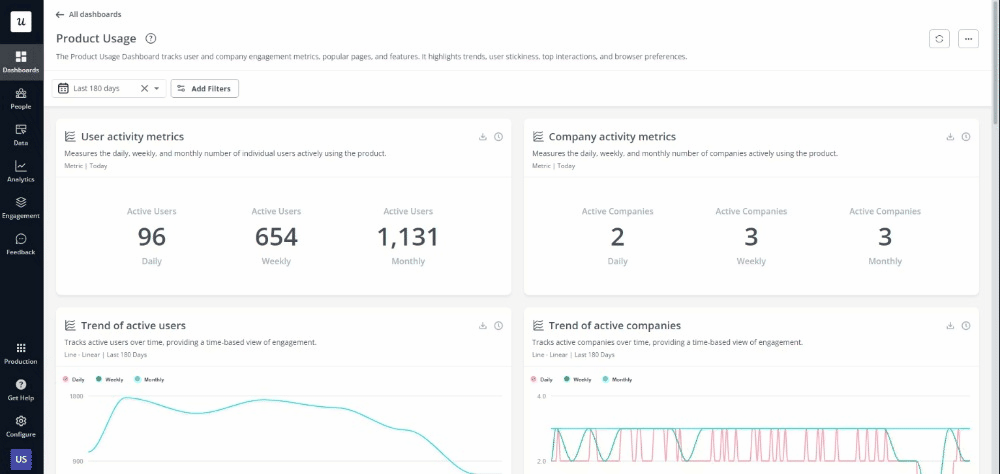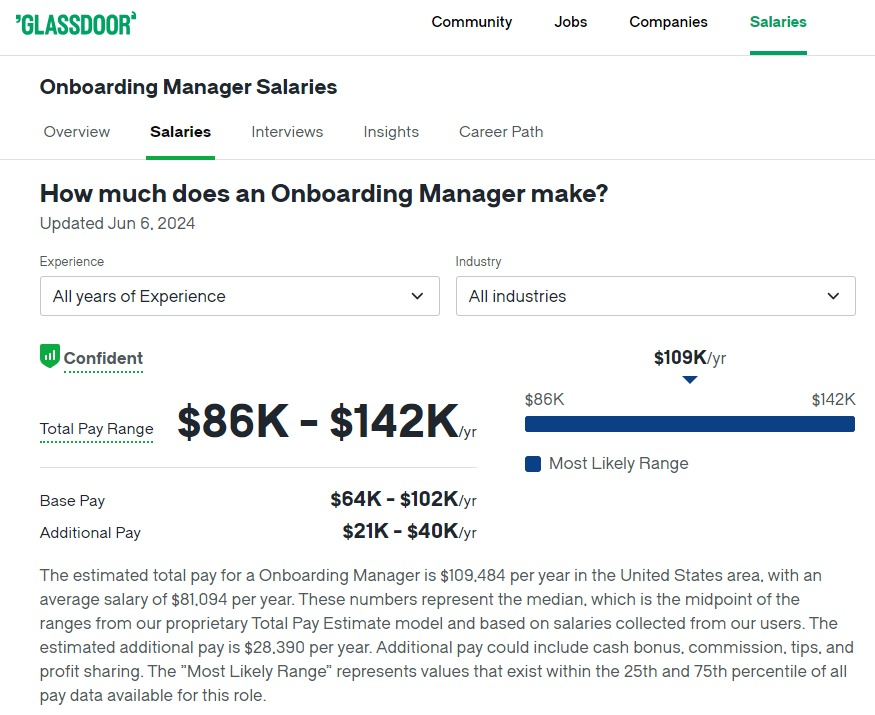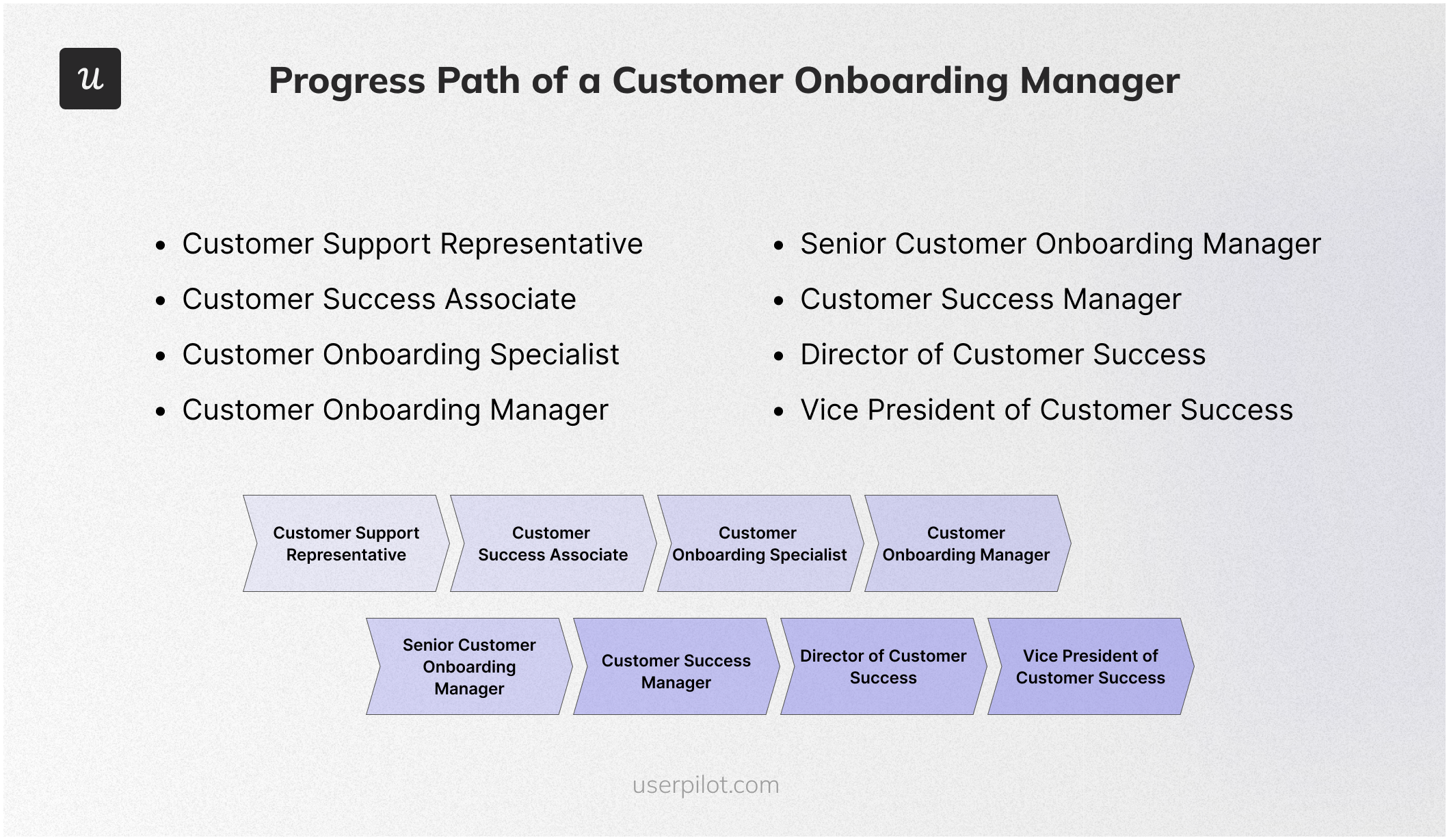
What is a Customer Onboarding Manager? Responsibilities, Salaries, and More
Whether you’re a seasoned professional or new to the field, understanding the nuances of customer onboarding managers is essential for success.
In this guide, we’ll delve into the core responsibilities, salary insights, essential skills, and more, providing you with the knowledge and tools you need to excel as a customer onboarding manager.
Try Userpilot Now
See Why 1,000+ Teams Choose Userpilot

TL;DR
- A customer onboarding manager is the maestro of a SaaS customer’s initial experience, ensuring a smooth transition from sign-up to successful product use.
- Customer onboarding manager salaries range from $65,000 to $140,000 USD depending on experience level and location, with higher salaries found in major tech hubs like San Francisco and New York City.
- Looking into tools for customer onboarding managers? Userpilot is an all-in-one product platform with engagement features and powerful analytics capabilities. Book a demo to see it in action!
What is a customer onboarding manager?
A customer onboarding manager is the maestro of a SaaS customer’s initial experience, ensuring a smooth transition from sign-up to successful product use.
In the SaaS industry, this role involves understanding customer needs, providing tailored training, and offering ongoing support to maximize product utilization and satisfaction.
Key tasks include configuring the software, conducting training sessions, monitoring user engagement, and addressing any issues that arise during the onboarding phase. Their ultimate goal is to enhance customer satisfaction and drive long-term product usage.
What does a customer onboarding manager do?
Customer onboarding managers are the architects of a positive first impression for SaaS companies. They orchestrate the entire new customer experience, from account setup and user training to ongoing communication and engagement. This ensures users not only understand the product’s features, but also see its value and become successful users.
Customer onboarding manager’s main responsibilities
Here are the main responsibilities and duties of a Customer Onboarding Manager, particularly in a SaaS (Software as a Service) environment:
Crafting the Onboarding Journey:
- Designing and Implementing the Program: This involves developing a comprehensive onboarding process that guides new customers from signup to product mastery. It might include elements like account setup workflows, personalized training modules, and interactive tutorials.
- Content Creation: They might create or curate onboarding content like knowledge base articles, video tutorials, and email drip campaigns to educate customers on product features and best practices.
- Streamlining Account Setup: They ensure a smooth and efficient account setup process, minimizing friction for new users.
Guiding and Supporting New Customers:
- User Training and Education: Customer onboarding managers deliver user training sessions, workshops, or one-on-one coaching to help customers understand the product’s functionalities and value proposition.
- Communication Champion: They maintain clear communication with new customers throughout the onboarding process, addressing questions promptly and fostering a sense of engagement. This might involve using various communication channels like email, phone calls, or live chat.
- Troubleshooting and Support: They provide initial troubleshooting support to new customers, resolving any technical issues or roadblocks they encounter during the onboarding phase.
Optimizing for Success:
- Metrics and Analytics: Customer onboarding managers track key onboarding metrics such as completion rates, time-to-value, and customer satisfaction. They analyze this data to identify areas for improvement and optimize the onboarding process for better user adoption and retention.
- Continuous Improvement: Based on data and customer feedback, they refine the onboarding program to ensure it remains effective and scalable as the product evolves.
Collaboration and Teamwork:
- Bridge Between Teams: They work closely with various teams within the organization, including sales, marketing, and customer success, to ensure a seamless handoff from initial acquisition to ongoing customer support.
- Alignment with Sales and Marketing: They collaborate with sales and marketing teams to ensure the onboarding experience aligns with the messaging and promises made during the pre-sales process.
- Providing Feedback: They provide valuable feedback to product development teams about user needs and challenges identified during the onboarding process.
In essence, customer onboarding managers are the orchestra conductors of the onboarding experience. They ensure all the elements work together to create a smooth and successful transition for new customers, ultimately driving product adoption and retention.
Customer onboarding manager salary
Here’s a breakdown of Customer Onboarding Manager salaries based on experience level and location, compiled from Glassdoor, Indeed, and Reed:
Experience Level:
- Junior Customer Onboarding Manager (2-4 years experience):
- Salary Range: $65,000 – $85,000 USD (Glassdoor)
- Salary Range: £45,000 – £60,000 GBP (Indeed)
- Salary Range: €55,000 – €75,000 EUR (Reed)
- Senior Customer Onboarding Manager (5-7 years experience):
- Salary Range: $80,000 – $105,000 USD (Glassdoor)
- Salary Range: £55,000 – £75,000 GBP (Indeed)
- Salary Range: €70,000 – €90,000 EUR (Reed)
- Customer Onboarding Director (8+ years experience):
- Salary Range: $110,000 – $140,000 USD (Glassdoor)
- Salary Range: £70,000 – £90,000 GBP (Indeed)
- Salary Range: €85,000 – €110,000 EUR (Reed)
Location:
High-Cost Cities: Salaries tend to be higher in major tech hubs and cities with a high cost of living. Here are some examples for Senior Customer Onboarding Managers:
- San Francisco, CA, USA: $110,000 – $130,000 USD (Glassdoor)
- New York City, NY, USA: $100,000 – $120,000 USD (Glassdoor)
- London, UK: £80,000 – £100,000 GBP (Indeed)
- Paris, France: €80,000 – €100,000 EUR (Reed)
Mid-Cost Cities: Salaries can be slightly lower in mid-sized cities but still offer a competitive advantage. Here are some examples for Senior Customer Onboarding Managers:
- Austin, TX, USA: $90,000 – $110,000 USD (Glassdoor)
- Denver, CO, USA: $85,000 – $105,000 USD (Glassdoor)
- Manchester, UK: £65,000 – £85,000 GBP (Indeed)
- Berlin, Germany: €70,000 – €90,000 EUR (Reed)
Remote Positions: Salaries for remote positions may vary depending on the company location but typically fall within the national or regional averages.
Please keep in mind that these are just general ranges, and your actual salary can vary depending on factors like your specific skills, qualifications, company size, industry, and negotiation skills. Bonuses, commissions, and stock options can also be part of the total compensation package.
Customer onboarding manager career path
The career path for a customer onboarding manager typically involves progressing through various roles focused on customer support and success, each building the skills and experience needed for higher-level responsibilities.
- Customer Support Representative: Provide frontline support to customers, resolving issues and answering questions. Progression involves developing strong communication and problem-solving skills and gaining a deep understanding of the product.
- Customer Success Associate: Assist in ensuring customers achieve their desired outcomes through the company’s product or service. Progression involves focusing on building relationships and understanding customer needs and learning about customer success metrics and strategies.
- Customer Onboarding Specialist: Guide new customers through the onboarding process, ensuring they understand and can effectively use the product. Progression involves honing project management and training skills, and gaining experience in configuring and personalizing software for clients.
- Customer Onboarding Manager: Oversee the entire onboarding process, manage a team of onboarding specialists, and develop onboarding strategies. Progression involves focusing on leadership, strategic planning, and improving onboarding processes for better customer outcomes.
- Senior Customer Onboarding Manager: Lead complex onboarding projects, mentor junior managers, and collaborate with other departments to improve the customer journey. Progression involves developing expertise in customer success and onboarding and building a track record of successful onboarding initiatives.
- Customer Success Manager: Ensure overall customer satisfaction and retention, manage customer relationships, and work to maximize customer lifetime value. Progression involves leveraging onboarding experience to enhance customer success strategies and focusing on broader customer success metrics and long-term goals.
- Director of Customer Success: Oversee the entire customer success department, including onboarding, support, and retention strategies. Progression involves leading company-wide customer success initiatives, developing and implementing high-level strategies, and driving overall customer satisfaction and retention.
- Vice President of Customer Success: Lead the customer success function at the executive level, aligning customer success strategies with overall business goals. Progression involves influencing company strategy, working closely with other executives, and ensuring the customer success team drives significant business impact.
Each role requires a mix of customer-centric skills, product knowledge, and strategic thinking, with progression often involving increased responsibility, leadership, and influence within the company. Continuous learning and adapting to new customer success trends and technologies are crucial for advancement.
Best practices for being a great customer onboarding manager
Customer onboarding managers play a pivotal role in shaping a user’s first impression and setting them on the path to success.
By implementing effective onboarding strategies, you can ensure new customers not only understand your product’s value proposition but also become active and engaged users.
Here are five key best practices to help you become a great customer onboarding manager:
- Craft a Seamless Onboarding Journey: Design a clear and comprehensive onboarding program tailored to your specific customer segments. This might include interactive tutorials, personalized welcome emails, and tiered training modules that progressively educate users on product features and best practices.
- Embrace the Power of Content: Develop engaging onboarding content in multiple formats (videos, written guides, interactive walkthroughs). Cater content to different learning styles and make it easily accessible within the product or a dedicated knowledge base.
- Become a Data-Driven Optimizer: Track key onboarding metrics like completion rates, time-to-value, and customer satisfaction. Analyze this data to identify areas for improvement and continuously refine your onboarding program for maximum impact.
- Communication is Key: Maintain clear and consistent communication with new customers throughout the onboarding process. Utilize various channels (email, live chat, phone calls) to answer questions promptly and address any concerns they might have.
- Foster a Collaborative Spirit: Onboarding success often hinges on collaboration across various teams (sales, marketing, customer success). Foster open communication channels and work together to ensure a smooth customer journey from pre-sales all the way to ongoing support.
By embracing these best practices and focusing on continuous improvement, you can create a world-class customer onboarding experience that drives product adoption, increases customer retention, and ultimately fuels your company’s growth.
Remember, a well-designed onboarding program is an investment in your customers’ success, and their success is your success.
Customer onboarding manager FAQs
What are the key metrics for measuring successful customer onboarding?
Success in onboarding goes beyond vanity metrics. Track metrics that reflect user activation, engagement, and value realization. Here are some key ones:
- Time-to-value (TTv): How quickly do customers achieve their first win with your product?
- Feature adoption: Are users exploring and utilizing core functionalities?
- Customer churn rate: How many customers are canceling after onboarding?
- Net Promoter Score (NPS): How likely are customers to recommend your product after onboarding?
- Customer Satisfaction (CSAT): Are customers happy with their onboarding experience?
How can I personalize the onboarding experience for different customer segments?
Personalization fosters a more engaging experience. Consider segmenting users based on factors like company size, industry, or signup plan. Here’s how:
- Tailor content: Provide targeted onboarding materials (e.g., guides, tutorials) relevant to specific user needs and goals.
- Highlight relevant features: Showcase functionalities that directly address each segment’s pain points.
- Utilize user data: Leverage onboarding behavior to personalize in-app messages and recommendations.
What are the best practices for creating effective onboarding content?
Effective onboarding content is clear, concise, and action-oriented. Here are some best practices:
- Keep it focused: Prioritize essential information and avoid overwhelming users.
- Use visuals: Screenshots, explainer videos, and infographics enhance understanding.
- Offer multiple formats: Cater to different learning styles with text guides, video tutorials, and interactive elements.
- Maintain a clear tone: Use a conversational yet professional tone that aligns with your brand voice.
How can I automate tasks to streamline the onboarding process?
Automation frees you to focus on strategic initiatives. Here are areas for automation:
- Welcome emails: Set up automated email sequences to deliver key information at pre-defined intervals.
- In-app walkthroughs: Create automated tooltips and product tours that guide users through core functionalities.
- Task management: Utilize project management tools to automate task assignments and track onboarding progress for different users.
How can I measure the ROI (return on investment) of my customer onboarding program?
Onboarding directly impacts customer acquisition and retention. Here’s how to measure ROI:
- Calculate customer lifetime value (CLTV): This metric estimates the total revenue a customer generates over their relationship with your company. Increased onboarding effectiveness typically leads to higher CLTV.
- Track customer acquisition costs (CAC): Effective onboarding reduces churn and the need for reacquisition efforts, lowering CAC.
- Analyze onboarding program costs: Compare the costs of your onboarding program with the revenue gains from improved customer acquisition and retention.
Conclusion
We hope this guide has provided you with valuable insights into the roles, responsibilities, and rewards associated with this role.
Looking into tools for customer onboarding managers? Userpilot is an all-in-one product platform with engagement features and powerful analytics capabilities. Book a demo to see it in action!










